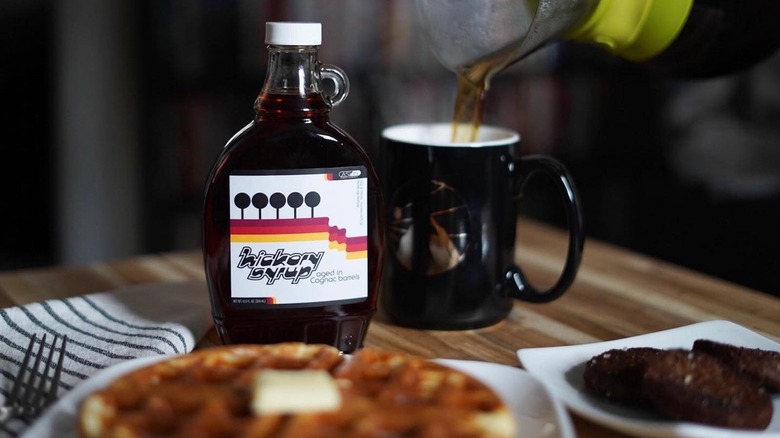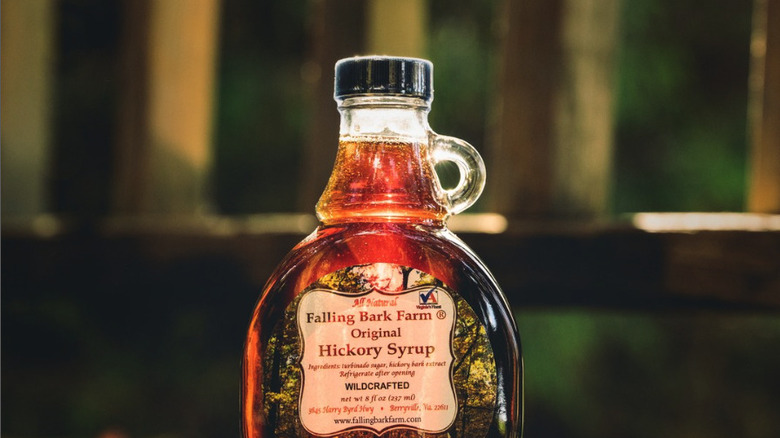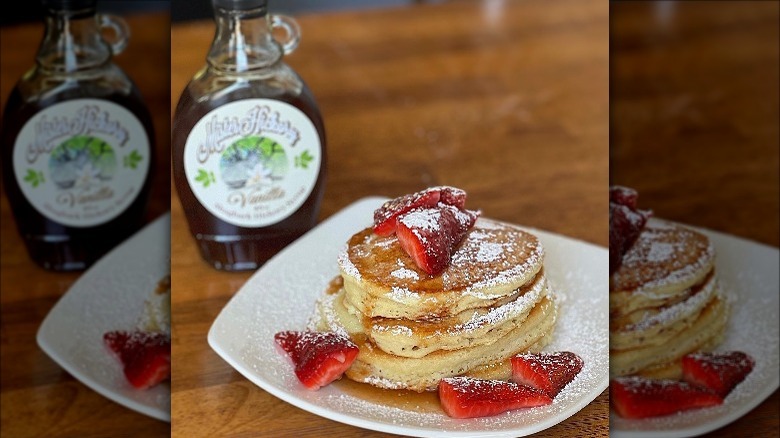Hickory Syrup Is The Maple Alternative You May Not Have Heard Of
Have you heard of hickory syrup? It's the sweet, smoky cousin of the ever-popular maple syrup. With its deep, rich flavor and dark amber color, this condiment has been slowly gaining popularity in the culinary world as an alternative to maple syrup, in part, due to the fact that you can make it yourself at home.
Instead of using tree sap as the base (which is the case for maple syrup), hickory syrup, aka shagbark syrup, is made from live, harvested, and roasted shagbark hickory bark, which is made into a tea, mixed with sugar, and cooked down. It boasts a unique blend of sweet, toasted, and smoky flavors.
The base of the syrup comes from shagbark hickory trees, which are native to the Eastern United States (and on down through Georgia, Alabama, Mississippi, and Louisiana) and Canada. Due to its rising popularity, you might find the syrup at your local farmers' market or specialty food store. Or, you can always order it online from various artisanal producers nationwide.
From savory sauces and marinades to sweet baked goods, it can add complexity and depth to various recipes. Here's what to know about how to make your own, along with some of the best dishes to prepare using this curious ingredient. Grab a bottle and let's dive into the wild, smoky-sweet world of hickory syrup.
How hickory syrup is made
While you can buy commercial hickory syrup, Alan Bergo, James Beard Award-winning chef and guest star on "Chefs vs. Wild," offers a quick guide on how to make your shagbark hickory syrup at home.
As an experienced forager, he notes that it all starts with a fun adventure into the woods to find living shagbark hickory tree bark (the dead stuff won't do). You can identify a shagbark hickory tree by its markedly unique bark that sheds in large chunks as it ages. Choose the cleanest pieces you can find, and then scrub 'em with a brush to ensure they're free of dirt, bugs, and other forest dwellers.
Roasting it gently over a fire gives it a smoky flavor that'll lend itself well to the eventual syrup you're going to sample. Once the bark is nicely toasted, break it into pieces and throw it into a pot of simmering water. How much bark should you be cooking? Bergo notes that ½ pound of bark will make about four cups of tea, so measure accordingly.
Let the bark simmer for about an hour, and strain the resulting hickory bark tea so you can measure the leftover liquid. Whatever that volume is, add the same amount of sugar and let the heat rise to 225 degrees Fahrenheit. Et voilà — you've got homemade hickory syrup.
How to use hickory syrup in the kitchen
When it comes to the bold flavor of shagbark hickory syrup, you'll find it to be slightly smokier than its maple counterpart. Valerie Lowry, co-owner of Back Creek Farms, told The Takeout, "We've had people write us entire pages of emails about how it brings back memories of campfires."
This tree syrup has a unique taste that, with its distinct smoky flavor, strikes the perfect balance of sweet and savory. But aside from using it to smother a stack of hot, fluffy pancakes or as a dip for some nice French toast, how else can you use hickory syrup in the kitchen?
Lowry suggests using it on pork-based dishes or even as a glaze for salmon. Try drizzling it over some roasted sweet potatoes and then using it as a glaze for a pork loin roast. For dessert, mix it into some vanilla ice cream or top a warm apple crisp or some sweet, tender figs with a generous pour for an indulgent treat.
Another unique way to use shagbark hickory syrup is in a cocktail. Its smoky and complex flavor profile makes it a perfect addition to any whiskey-based drink. Mix it with some bourbon, lemon juice, and a splash of sparkling water for a unique, campfire-inspired twist on the classic whiskey sour.


